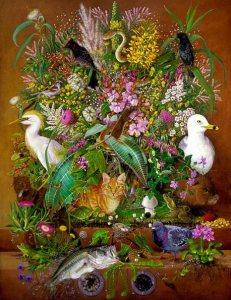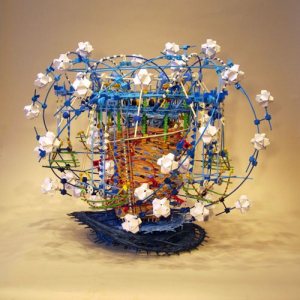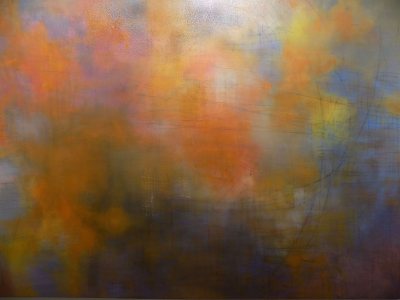Combining Environmental Studies and Art into a curatorial internship

Isabella Kirkland, Ascendant, 2000, digital print, 35 x 26 inches
Over the past year, I have been working with the museum’s director, Dan Mills, as a curatorial intern for the exhibition, Anthropocenic: Art About the Natural World in the Human Era. This exhibition, which highlights art that addresses the human impact on the natural world, will provide audiences with much to contemplate and may inspire students, faculty, and people in the surrounding communities to participate in the protection of their local environment.
This internship, and exhibition, couldn’t be occurring at a more perfect time in my academic career. I am an Environmental Studies major who finds myself increasingly drawn to the world of art. Having grown up around my dad’s gallery and my mom’s photography, I spent my life exposed to both the beauty of fine art and the messages it communicates. But my passion for art history and museum studies didn’t really emerge until I started at Bates.
In addition to my Environmental Studies courses, I began taking more Art History classes during my sophomore year. But the most enlightening experience has been this internship that fuses my two passions into an educational, cohesive, and critical exhibition. Through this internship I have come to appreciate the abundance of artists that uniquely comment on the state of our natural world. After all, art has always held an important position in initiating change and spreading knowledge. This exhibition certainly has challenged me to consider my role as a human in the natural world and to educate my peers on the climate crisis at hand.

Nathalie Miebach, In the Shadow of a Giant, 2013, sculpture 3D musical score, 32 x 32 x 25 inches
It can be difficult to curate a seamless exhibit with a group of distinct artists, from near and far, in a single space. However, as I learned from Dan, it is crucial to represent a broad range of conceptual approaches, media, and perspectives, especially with a topic as global as this one. We included artists who create installation pieces, large aerial photography books, film, abstract painting, and more. Some of Anthropocenic’s artists address the topic from an explicit standpoint. For example, Jan Piribeck exposes unusual weather in her neighborhood, and Isabella Kirkland paints species that have gone extinct due to human action. Other artists paint more abstract images of the Anthropocene. Paintings by other artists are more abstract portraits of the Anthropocene era. For example, Michel Droge’s paintings are abstract interpretations of the post-human era, and Nathalie Miebach’s innovative sculptures reference the dramatic weather “scores” of climate change. This breadth should appeal to the museum’s audiences, and will speak to a wide range of environmental concerns that will ultimately affect all of us.

Michel Droge, Remembering Tomorrow, 2018, oil on panel, 63 x 75 inches
In addition to discussing and researching art and artists with Dan, I also worked on a 3D digital model of the exhibition, with SketchUp. A lot of the work I did for this internship also involved writing summaries of each artist’s piece, their work and practice, or their relevance to the theme of the exhibition. Working with SketchUp exposed me to an important application, with which we could virtually install the exhibition and visualize the composition of the space through technology before we physically install the work. I appreciated gaining this technological knowledge, and balancing that with the writing I did as well.

Jan Piribeck, image from The Back Cove Project, 2001, LED image, 24 ½” x 30 ½”
It has been a challenging, educational, and thought-provoking experience serving as an intern for this exhibition. I discovered that a college museum could be one of the most pivotal platforms for sparking environmental stewardship in students. Working on this exhibition also reminded me that art and the environment do not have to be separate fields of study. In fact, they can coexist and mutually inform each other like they do in this exhibition. Since discovering this, I am inspired to infuse art into my environmental research throughout my senior year and future studies. I will be working with a sustainable landscape designer over the summer, combining my academic knowledge of environmental studies with my passion for design. Similarly, I plan to write my thesis next semester on how the post-Word War II houses of Southern California can be used as models for sustainable design today. Again, serving as an intern for Anthropocenic has inspired me to work in fields, and research topics, that incorporate my two passions.
Emerson Krull, ’19
Environmental Studies